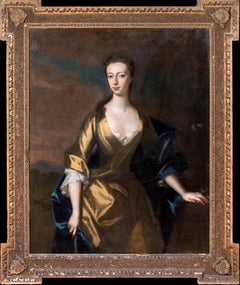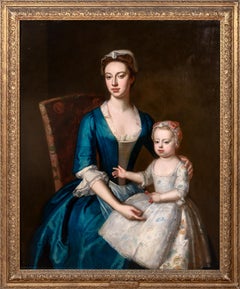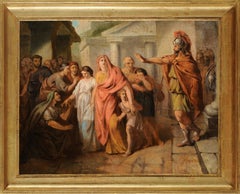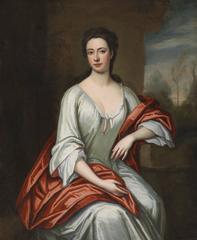Enoch Seeman Paintings
to
2
2
Overall Width
to
Overall Height
to
2
2
1
2
2
2
1
2
2
1
1
2
781
715
704
691
2
2
Artist: Enoch Seeman
Portrait Of Miss Jones of Fonman Castle, Wales, circa 1730 by ENOCH SEEMAN
By Enoch Seeman
Located in Blackwater, GB
Portrait Of Miss Jones of Fonman Castle, Wales, circa 1730
by ENOCH SEEMAN (1689-1744)
Large 18th century three quarter length portrait of Miss Jones of Fonmon Castle, Wales, oil on canvas by Enoch Seeman. Excellent quality and condition portrait of a young Miss Jones wearing a gold satin dress...
Category
18th Century Enoch Seeman Paintings
Materials
Canvas, Oil
$9,822 Sale Price
25% Off
Portrait Of Elizabeth Plumer (nee Byde) & Daughter, circa 1735
By Enoch Seeman
Located in Blackwater, GB
Portrait Of Elizabeth Plumer (nee Byde) & Daughter, circa 1735
by ENOCH SEEMAN (1694-1744)
Large 1735 portrait of Elizabeth Plumer & her daughter holding a rattle, oil on canvas by...
Category
18th Century Enoch Seeman Paintings
Materials
Canvas
$8,519 Sale Price
25% Off
Related Items
Spanish grape picker oil on canvas painting
Located in Sitges, Barcelona
Lafuente - Grape harvester - Oil on canvas
Spanish school signed "Lafuente".
Oil measures 61x50 cm.
Frameless.
Category
1950s Modern Enoch Seeman Paintings
Materials
Canvas, Oil
Alexander the Great in the Darius house
Located in BELEYMAS, FR
French School, Late 18th Century
Alexander the Great in the House of Darius
Oil on canvas
H. 42 cm; W. 53.5 cm without frame
Apocryphal signature lower right "Verhag..."
This painti...
Category
1780s French School Enoch Seeman Paintings
Materials
Canvas, Oil
Eastern European Mannerist Portrait in traditional dress 19th/18thC
Located in Hillsborough, NC
Eastern European young woman in traditional dress with silver lacings and jewelry holding an open book. This portrait pose is in the Renaissance period Mannerist style, and the young...
Category
17th Century Mannerist Enoch Seeman Paintings
Materials
Canvas, Oil
$1,595 Sale Price
44% Off
H 18 in W 14 in D 2 in
Peter Robert Keil Gold Framed Painting on Canvas Signed and Dated with COA
By Peter Robert Keil
Located in Hudson, NY
Peter Keil's textured painting on canvas. Signed and dated 1997. This one is stunning in person. Background paint is textured on the canvas. Amazing gilt frame with a textured fabric...
Category
Mid-20th Century Cubist Enoch Seeman Paintings
Materials
Gold Leaf
$1,020
H 21 in W 17.13 in D 1.25 in
"Femme et Homards" (Woman with Lobsters), 1948 -André Minaux (French, 1923-1986)
By Andre Minaux
Located in Berlin, MD
Behold a mid-century marvel by André Minaux, a titan of the French School whose stylized Social Realist visions continue to captivate the art world. Painted in 1948, “Femme et Homard...
Category
Mid-20th Century French School Enoch Seeman Paintings
Materials
Cotton Canvas, Oil
$5,135
H 62.25 in W 43.5 in D 3 in
Venice Landscape Italian Oil on Canvas Painting in Gilt Wood Frame, Belle Epoque
Located in Firenze, IT
This delightful turn of the century (early 20th century) oil on canvas painting represents an Italian landscape with one of the most famous squares in the world: Piazza San Marco in ...
Category
Early 20th Century Impressionist Enoch Seeman Paintings
Materials
Canvas, Oil
Venice Landscape Italian Oil on Canvas Painting in Gilt Wood Frame, Belle Epoque, Early 20th Century
$8,372 Sale Price
25% Off
H 51.19 in W 33.47 in D 1.19 in
“Enfant A La Collarette” The Child in the Collar.
By René Genis
Located in Berlin, MD
Rene Genis (French 1922-2004) “Enfant A La Collarette” The Child in the Collart. Portrait of a disturbing young man with a rather defiant, petulant look in his expression. Dark eye...
Category
Mid-20th Century Enoch Seeman Paintings
Materials
Canvas, Oil, Laid Paper
$2,025 Sale Price
48% Off
H 24 in W 16 in D 1 in
Portrait of a Shepherd dog, oil painting on canvas early 20th c.
Located in Gavere, BE
Portrait of a Shepherd dog, oil painting on canvas early 20th c.
Extra info about the painting :
Title: Portrait of a Shepherd dog
Materials : oil on canvas
Signature: bottom le...
Category
1920s Other Art Style Enoch Seeman Paintings
Materials
Canvas, Oil
$5,863
H 25.2 in W 22.05 in D 3.15 in
Madonna and child, Italian school, 18th century
Located in DEVENTER, NL
Italian School, 18th century
Depicted are the Madonna and Child Jesus, the virgin Mary is holding the Child Jesus lovingly in her arms. The child, lying on a bundle of cloth and with...
Category
18th Century Enoch Seeman Paintings
Materials
Canvas, Oil
Holy family under an oak tree on a gold background
Located in BELEYMAS, FR
French school circa 1870
Holy Family under an oak, after Raphaël, on gold background
Oil on canvas
H. 92 cm; W. 60 cm
This aesthetic curiosity takes up the very famous composition b...
Category
19th Century French School Enoch Seeman Paintings
Materials
Canvas, Oil
Large French Oil painting On Canvas, portrait of a musketeer 19th century
Located in Gavere, BE
Beautiful Oil On Canvas, portrait of a musketeer French school 19th century
This is a French 19th century school with large dimensions .
Very decorative and exclusive portrait paint...
Category
1890s French School Enoch Seeman Paintings
Materials
Gold Leaf
$11,162
H 35.44 in W 24.81 in D 0.79 in
Portrait of a young woman in Louis XV period dress
Located in BELEYMAS, FR
French School
Portrait of a young woman in Louis XV period dress
Pastel on paper mounted on oval canvas
H. 68 cm; W. 54 cm (Frame: H. 102 cm; W. 71 cm)
18th century frame, anti-refle...
Category
Mid-18th Century French School Enoch Seeman Paintings
Materials
Canvas, Paper, Pastel
Previously Available Items
18th century Portrait of a Lady with a red cloak
By Enoch Seeman
Located in Bath, Somerset
Attributed to Enoch Seeman the Younger (1661-1744). Portrait of a Lady, seated in a landscape wearing a white silk gown with red cloak, leaning on a stone...
Category
Early 18th Century Baroque Enoch Seeman Paintings
Materials
Canvas, Oil
Portrait of a Lady
By Enoch Seeman
Located in Bath, Somerset
Attributed to Enoch Seeman (Poland 1661-1745 London). Portrait of a Lady, seated in a landscape wearing a white gown with red cloak. C. 1720. Oil on canva...
Category
18th Century and Earlier Enoch Seeman Paintings
Materials
Oil
Enoch Seeman paintings for sale on 1stDibs.
Find a wide variety of authentic Enoch Seeman paintings available for sale on 1stDibs.



